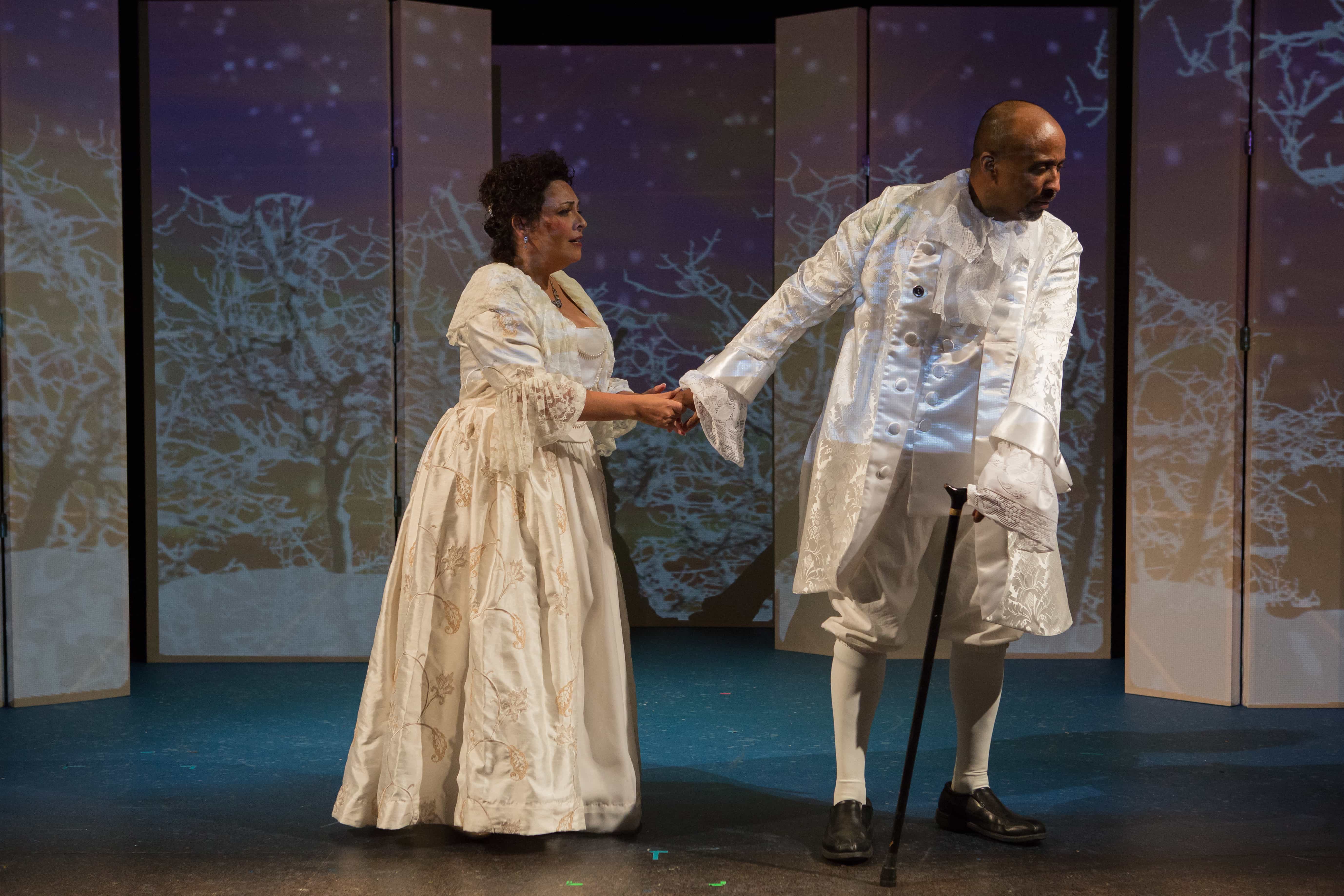From behind tall blank panels, a cast of characters drawn from Mozart’s The Marriage of Figaro emerge, dressed in all white period garb, staging vignettes of frustrated and consummated love punctuated by verse from T.S. Eliot’s “Four Quartets.”
Director Timothy Nelson’s Figaro in Four Quartets is an odd, highly ambitious opera uninterested in reproducing the traditional narrative of Mozart’s classic work, opting for a more philosophical approach that condenses parts of Figaro into an expression of eternal recurrence of life’s whimsical nature aptly expressed by the original’s playful romantic mechanics. This is a compelling conceptual experiment to say the least, though in execution prone to feeling inaccessible and convoluted, especially for those who might be unfamiliar with the source material.

A nameless poet (Brian J. Shaw) dressed in contemporary clothes opens the show with recitations of selected text from Eliot’s highly metaphysical work, his lines evoking the transient, often cyclical nature of time as he leans into a corner of the stage decorated like a library nook. In between movements, the spotlight will return to the poet and his ruminations, as he seems to look on from a distance with an almost biblical authority at the action occurring center stage.
The main performance, sectioned off into four movements (Spring, Summer, Autumn, and Fall) and a finale, transitions back and forth between ensemble songs and arias, wherein each member of the singing cast is given only one solo showcase. Background projections illuminate the stage in a seasonally appropriate color palette and design (i.e. cherry blossoms and green for spring), the neon brightness of which will either look cheap or evocative of a discordant postmodern sensibility. In any case, songs are paired cleverly with the changing moods of the seasons– young lovers Cherubino (Cara Gonzalez) and Barbarina (Dawna Rae Warren) playfully flirt in the spring, while the Count’s (Brody DelBeccaro) vengeful scheming unfolds upon an emotional red and orange backdrop of autumn leaves.
The fragmented breakdown of the original, as well as seemingly faulty overhead subtitles (this production is sung in Italian), makes any sort of connected action in Figaro in Four Quartets rather difficult to follow. Nevertheless, much like the experience of reading poetry itself, the takeaway from this production is less a matter of concrete meaning, and more atmospheric and experiential. Narrative confusion, in a way, forces audiences to simply indulge in the musical experience, observe the shifting moods and tones of each performer as symbols of some natural order.
The Four Quartets functioning as a framing device is at the very least thought-provoking, though I can’t help but feel as if its sweeping existential declarations on life and love are general enough to apply to a number of artworks, making the link between Eliot and Mozart seem rather arbitrary and perhaps, forced to the point of dilution. This production too often betrays its experimental nature through this clunky mash-up of artistic forces, which seems to still be at the stage of a hypothetical.

The ensemble cast as a whole delivered an expert performance, but special recognition must be given to the ladies, in particular Teresa Ferrara as the Countess and Mia Rojas as Susanna. In “Dove sono,” Ferrara delivers an exquisite performance, her voice as powerful and full of longing as her character’s existential entreaties, while also demonstrative of an impressive level of control. Ferrara’s aria is the musical highlight of the entire production – for this critic, at least. Rojas, too, gives an energetic and full-bodied vocal performance in her coy aria, “Deh vieni non tardar,” and also in a physically demanding tete-a-tete with Figaro (Jim Williams) in the final act.
Fans of Mozart will find this adventurous production to be a curious take, though essentialists will undoubtedly recoil. In any case, the program should be required reading for those hoping to make sense of the intended connections. A few standout performers and an altogether solid cast is enough to make the music shine. Sitting back and simply enjoying the music and playful visuals as one would a traditional concert is not a terrible way to experience this show.
Costume Design – Donna Breslin; Set Design – Jonathan Dahm Robertson; Lighting Design – Marianne Meadows.
Running Time: One hour and 20 minutes, with no intermission.
Figaro in Four Quartets, presented by The In Series, plays through October 28, 2018, at GALA Hispanic Theatre, 3333 14th Street NW, Washington, DC. For tickets, call 202-204-7760, or go online.




